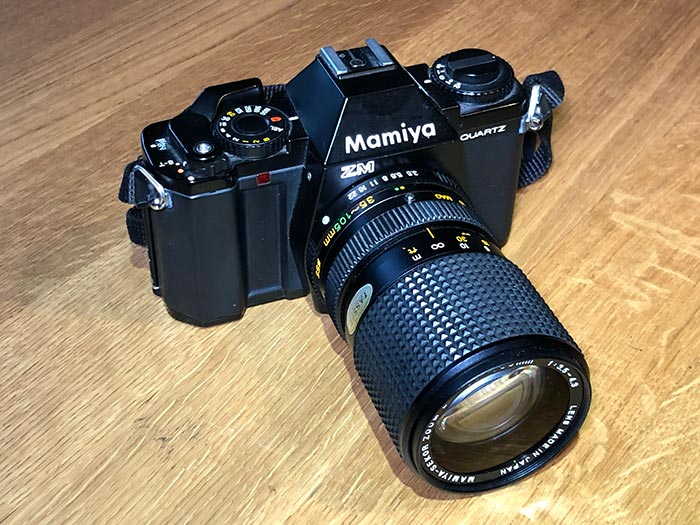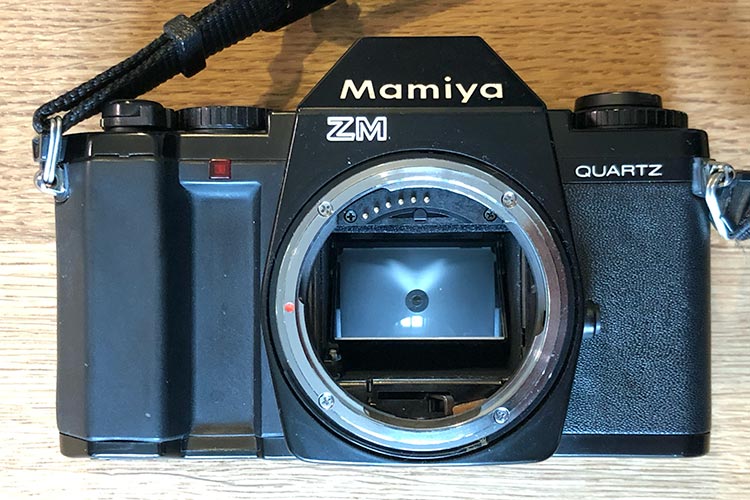Basic Information on the Mamiya Z mount:
The Mamiya Z-mount was introduced in 1980, together with the Mamiya ZE SLR. Due to unfortunate circumstances (the surprise bankruptcy of Osawa, Mamiya’s global distributor in 1984), the Mamiya Z-mount came to be the last 35 mm SLR lens mount used by Mamiya. To thoroughly understand the Mamiya Z-mount, a short history of Mamiya 35 mm lens mounts is needed, but if you just want to know about the lens mount and how to adapt it, you can jump forward.

A brief history of time Mamiya 35 mm SLR mounts
Mamiya is today most well-known for its medium format TLR’s, SLR’s (Mamiya 645, Mamiya 67 RB and 67 RZ), and medium format rangefinders (Mamiya 6 and Mamiya 7), but Mamiya was also heavily involved in the 35 mm format – both in lenses and SLR manufacture.
One indicator of Mamiya’s strong involvement in the 35 mm SLR market from 1961 to 1982 was that Mamiya often were at the forefront of technological development (First SLR to offer TTL spot metering, first Japanese camera manufacturer to implement electronic lens-body communication). Also, Mamiya was a highly trusted OEM manufacturer for major 35 mm involved brands – Japanese (e.g. Nikon) and European (Rollei-Voigtländer) alike.
Problematically, to be able to implement those new features, Mamiya was also frequently forced to implement new lens mount functionality, which often meant an entirely new mount1. After having started with the vanilla M42 mount (Mamiya TL and DTL series cameras), Mamiya next implemented their proprietary extension of the M42 mount (Mamiya SX, DSX and MSX series cameras) that was not compatible with other M42 cameras. Thereafter Mamiya went through three entirely proprietary bayonet mounts, referred to as the Mamiya NC bayonet; the Mamiya XTL bayonet; and finally, the Mamiya Z bayonet.
As Mamiya further had the bad habit of naming their lenses differently from their mounts, there is significant risk for confusion regarding which Mamiya lenses go together with which mount. Hopefully the table below will shed some light on the matter:
| Camera series | Lens mount / mount name | Lens type name | Example (on name ring) |
| Prismat | Exakta (proprietary variant)2 | F.C. | Mamiya-Sekor F. C. |
| TL & DTL | M42 (vanilla auto variant) | (none) | AUTO mamiya/sekor |
| SX, MSX, DSX | M42 (proprietary variant)3 | SX | AUTO mamiya/sekor SX |
| NC1000 | Mamiya NC | CS | AUTO MAMIYA-SEKOR CS |
| XTL & X-1000 | Mamiya XTL (a.k.a. Mamiya X) | ES | AUTO mamiya/sekor ES |
| Z | Mamiya Z | E/EF/E[…]S | MAMIYA-SEKOR E MAMIYA-SEKOR EF MAMIYA-SEKOR E […] S 4 |
Enter the Mamiya Z mount…
The Mamiya Z mount, introduced 1980 was definitely forward looking, as the mount specification included 10 (!) electronic contacts, even while the contemporary Mamiya ZE camera (the first camera in the Mamiya Z-series) used only three of those contacts (the subsequent camera models used six contacts (ZE-2 and ZM) or even more (ZE-X).

There are three subfamilies of Mamiya Z-mount lenses. The earlier Z-mount lenses go under the name (Mamiya-Sekor) E, while later lenses (with 11 electronic contacts) go under the name (Mamiya-Sekor EF). The main difference seems to have been the EF lenses were able to communicate (to a compatible body) the focusing distance (something Nikon implemented roughly a decade later in its AF-D lenses).
Thirdly, there is a sub-family of E lenses that were known as E”S” or E(S) lenses. The type name of these (based on lens name rings) was special in that the E and S were separated by the core specifics of the lens (As in: “MAMIYA-SEKOR E 50mm 1:1.7 S” This is a significant difference and helps distinguish these lenses from the “mamiya/sekor ES” lenses used by the predecessor series of cameras (Mamiya XTL/X-1000).
I’ve tried to find detailed information regarding what data those electronic contacts would be used to communicate, but with no luck so far. Maybe I’ll have to pick up a multimeter and find out for myself. It is also possible that the core functionality in some of these contacts has been essentially a form of lens coding (I honestly cannot imagine what else a manual lens would need 10 contacts for…)
There is – however one relatively quirky feature with Mamiya Z-lenses: While the lenses sport a classic aperture ring with click stops, that aperture ring actually does very little (it certainly does not manipulate the aperture). Instead, aperture control is based on a) the user selecting an aperture value; b) the lens communicating that value to the camera; the camera stopping down the aperture at the time of shooting.
One interesting aspect of the Mamiya Z mount is that it is – sort of – compatible with the Mamiya NC mount (Mamiya CS lenses), in that you could mount Mamiya CS lenses straight onto a Mamiya Z mount camera, but with a quirk: That such lenses would have limited compatibility (no way for the camera to stop down the aperture) and would be mounted at a 90° rotation.
Mamiya Z mount specifications
Mount type: Bayonet (male-type; lens release on body)
Flange focal distance: 45,5 mm
Film format: 36mm x 24mm (‘Full frame’)
Mount communication (mechanical): aperture ring position (lens-to-camera); aperture stop-down (camera-to-lens);
Mount communication (electronic): 10/11 electronic contacts. Entire extent of communication (designed/implemented) unknown to JAPB
Adapting Mamiya Z lenses
Given the abrupt end of the Mamiya Z camera lineup, Mamiya Z lenses have been a prime candidate for adapting for a long time. No surprise therefore, that there are numerous adapters (with optics) available both for dSLR mounts and adapters (without optics) for most mirrorless mounts.
Besides the ordinary caveats related to using adapters with optics, the Mamiya Z-mount has one quirk up its sleeve in that aperture control is not straightforward (See above). Hence, any Mamiya Z adapter must have a ring for controlling the lens’ aperture.
n.B! I have no personal experience in whether/how the Mamiya Z adapters support using Mamiya NC mount lenses.
Identifying Mamiya Z lenses
See more here.
Footnotes:
[1] While Mamiya went through 6 lens mounts (5 of which proprietary) in roughly a quarter century, Mamiya generally tried to take care to offer some form of backward compatibility through offering a decent range of adapter rings to allow mounting older lenses on newer bodies.
[2] The Mamiya Plasmat’s lens mount is generally referred to as an Exakta mount, but detailed knowledge online is relatively scarce. Imagery of Mamiya Plasmat (sekor F.C.) lenses reveal a construction that would indicate that interoperability may be somewhat limited.
[3] The proprietary addition made to the M42 mount in the SX line of lenses is the addition of a pin that travels together with the aperture ring, which the body could then use to read the selected aperture (thereby enabling metered aperture priority). As such, this implementation is closely related to Minolta’s meter coupling prong or the Nikon “rabbit ears”. Problematically, this pin (and the aperture ring that extended further towards the camera) preclude mounting Mamiya SX lenses on both most M42 cameras and most M42 adapters.
[4] The […] would typically contain the lens’ basic specifications: focal length and maximum aperture. The kit lens would therefore read: “MAMIYA-SEKOR E 50mm 1:1.8 S” (the “S” would be in red).
Read more:
Minolta SR lens index on minolta.eazypix.de
Rokkorfiles.com